Fall 2024
15 October, 2024
The fall 2024 anime season, for isekai fans, is very much a sequel season. Only two new isekai anime, Hitoribocchi no Isekai Kouryaku and Rekishi ni Nokuru Akujo ni Naru zo, premiere, but five older ones get new seasons.
Re:Zero kara Hajimeru Isekai Seikatsu’s season 3 is undoubtedly the headliner; this juggernaut of a franchise has already had four cours worth of TV anime, two movies, a director’s cut, an Isekai Quartet appearance, and 39 light novels. Arifureta Shokugyou de Sekai Saikyou also gets a (more typical) 3rd season, while Maou-sama, Retry! fans have waited five years for their 2nd season, Maou-sama Retry! R – and Seirei Gensouki fans have also waited three. Finally, Tensei Kizoku, Kantei Skill de Nariagaru’s 2nd season looks to be a usual and planned case of split cour; as I very much enjoy the manga, however, I hope it won’t end here.
I still refuse, perhaps stubbornly, to accept Sword Art Online as isekai; anime where characters are transported into an MMO fall on kind of a spectrum, and SAO’s world is very much just a (death) game. I may be splitting hairs a bit, or ultimately regret the decision, to not cover Maou 2099; plenty of isekai anime feature characters trying to prevent worlds from merging, so should it count as a reverse isekai if they already have? Seems like too much of a backstory element IMO. Also, despite heavy overlap, it is worth remembering that not every villainess anime is an isekai, nor is every anime featuring reincarnation and a fantasy setting; I’m watching both Yarinaoshi Reijou wa Ryuutei Heika wo Kouryaku-chuu and Sayonara Ryuusei, Konnichiwa Jinsei but neither of them have another world to talk about. Still, if seven seasonal anime aren’t enough, they’re at least worth a mention.
Isekai protagonists, even when summoned alone, tend to form powerful friendships in the other world, and in a world where human connection is hard to come by, it can be part of the genre’s appeal. Yet not everyone minds being alone, and anime has produced some wonderful adventure stories about lone travelers, of which Kino no Tabi and Majo no Tabitabi come to mind, or perhaps Kumo desu ga, Nani ka? in an isekai context, although that’s more of a dungeon crawl. It would have been nice for Hitoribocchi no Isekai Kouryaku to become another story in that vein; unfortunately, however, the title is a fucking lie; the main character may not like people particularly much, or belong to any of his school’s cliques, but he rarely spends much time alone.
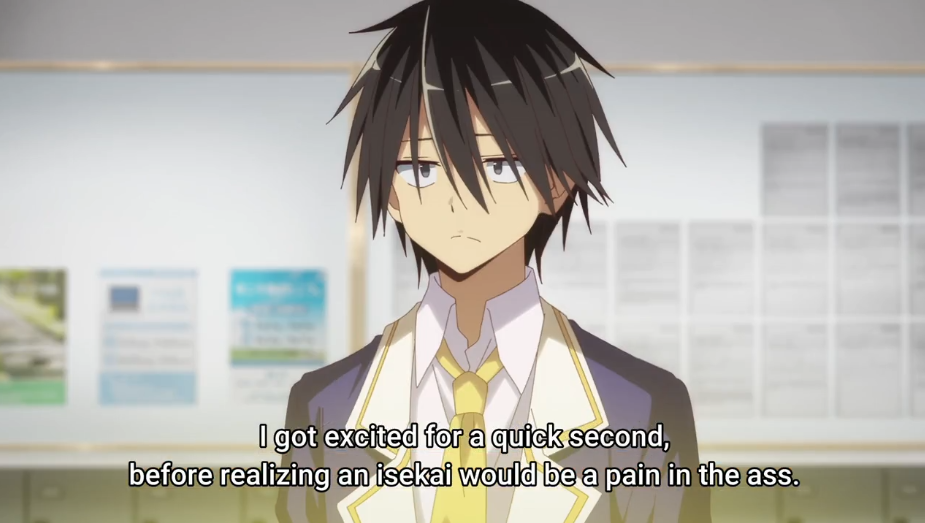
The idea of entire classes getting summoned goes back to at least the influential 1972 horror manga Hyouryuu Kyoushitsu, the 1990s brought along a bunch of classmates and a teacher in El-Hazard, and even this season, Arifureta is probably the most prominent example of the trope in contemporary isekai. Where Hitoribocchi distinguishes itself is in the class dynamics; the delinquents see it as a rape opportunity, the otaku come well-prepared, the class rep tries in vain to keep the group together.
And in the cute monster designs.


The main character, Haruka, is last to the other world and only gets leftover skills, but ‘packing’ is surprisingly useful, his luck is maxed out, and he handles the adjustment well enough that he’s got a house built for the girls to board at only three episodes in - unlike much of the class, who very much struggles.

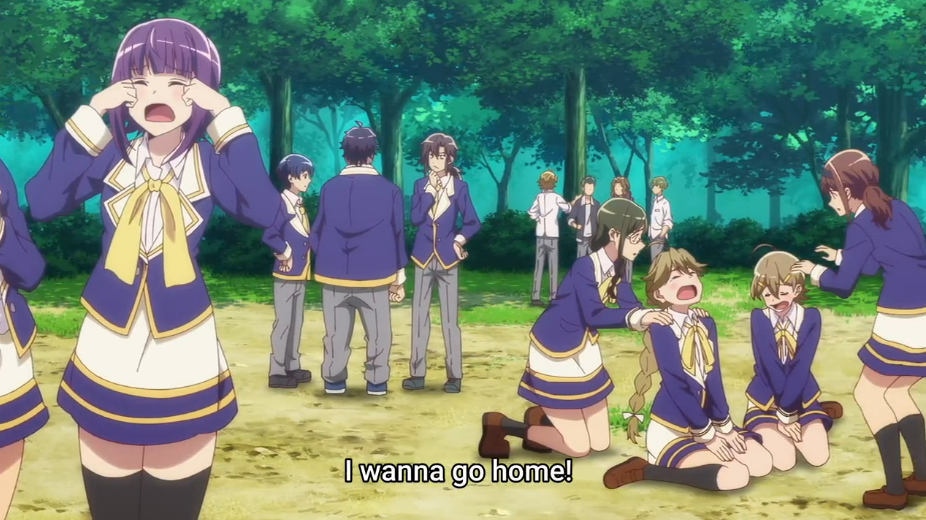
Unfortunately, any lewd situations or pseudo-harem shenanigans are missing from this anime, which is censored further from a manga that already toned down the LN’s ecchi; I think the delinquent plot in particular suffers as a result, and cute enough girls have long let anime distinguish themselves.
As things stand, its a bit of a mixed bag, and might be forgettable if airing in a more crowded season, but the difficulties of coping with being summoned and the changed social dynamics of the scenario are enough to at least keep me watching. Plus there's an accidental subjugation (read: brainwashing) spell, that's always fun.
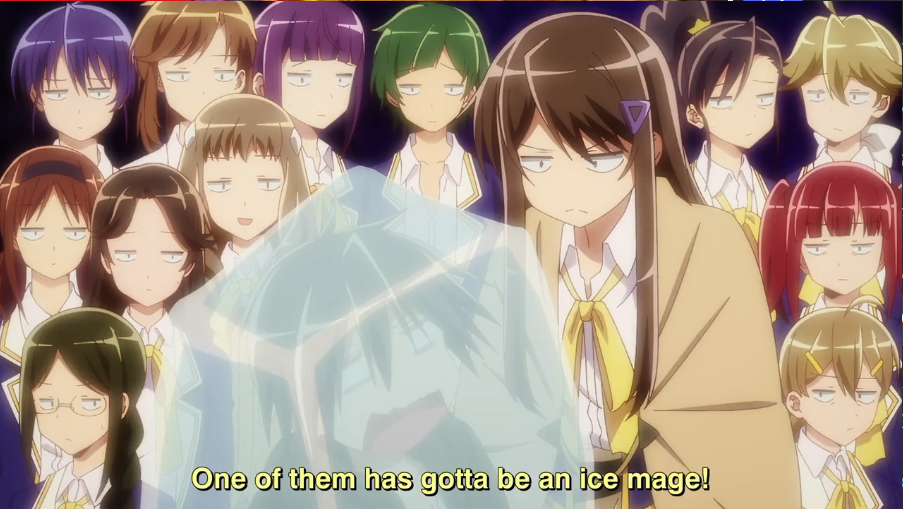
Class systems are inherently a part of the villainess genre; the “reijou” in “akuyaku reijou” (or shortened to “akujo”, as in Rekishi ni Nokoru Akujo ni Naru zo refers not to any young woman, but a female aristocrat. And aristocrats, it should not be forgotten, get all those nice and luxurious rooms not (only) through superior magical skill, but through exploiting the labor of their serfs; it is no coincidence that Versailles no Bara, which decades later remains the most prominent portrayal of European aristocracy in Japanese culture, ends with the French Revolution. The dark side of these systems are by no means new to villainess stories; a personal favorite of mine, Tearmoon Teikoku, features a heroine trying to avoid such an outcome, and commoner heroines facing prejudice for their background are by no means rare.
Rekishi ni Nokoru Akujo ni Naru zo, even against the backdrop of this genre, is a series which stands out for its class consciousness. And it does not hurt that the “villainess” in question, like many to hold that title, is far more of a tsundere than a bully, always using her role to justify helping others.
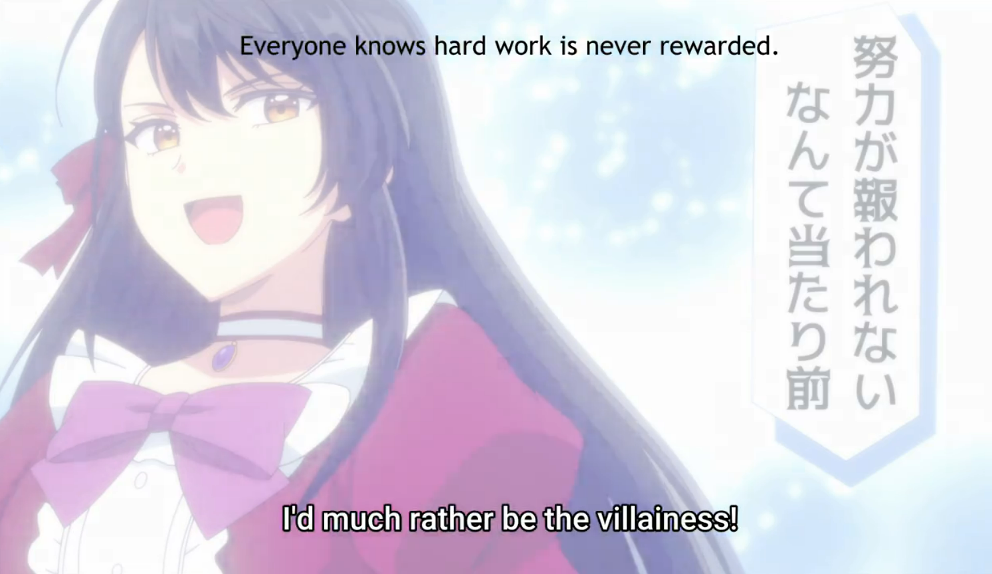 We should not mistake Alicia for a modern revolutionary; although concerned about the poverty of her country, she is more than willing to export the problem through imperial expansion.
We should not mistake Alicia for a modern revolutionary; although concerned about the poverty of her country, she is more than willing to export the problem through imperial expansion.

Yet there’s plenty to sympathize with in her interactions with a man in the forest who had been blinded for speaking rudely to an aristocrat, or in her finding a healing herb to save the life of a bullied child, and its certainly enjoyable to see her insult the very system of aristocracy to the king with his major ministers present.

 I don’t know if she can become the isekai answer to Ginga Eiyuu Densetsu’s Reinhard von Lohengramm (or better yet, launch a revolution without seeking to conquer others) but I’m pulling for her.
I don’t know if she can become the isekai answer to Ginga Eiyuu Densetsu’s Reinhard von Lohengramm (or better yet, launch a revolution without seeking to conquer others) but I’m pulling for her.
Re:Zero Hajimeru Isekai Seikatsu is a title which needs no introduction, especially on its 3rd season, and the rare anime that can drop a 90 minute first episode (longer than either of its actual movies!) and get away with it. I’m not sure doing this as a single episode was required, as the start serves to effectively reintroduce the cast and brings them (or at least the ones going; Rem sadly remains in her coma) to the beautiful water city/gate of Priestella. It could’ve been an episode 1 before getting us onto the new plot.
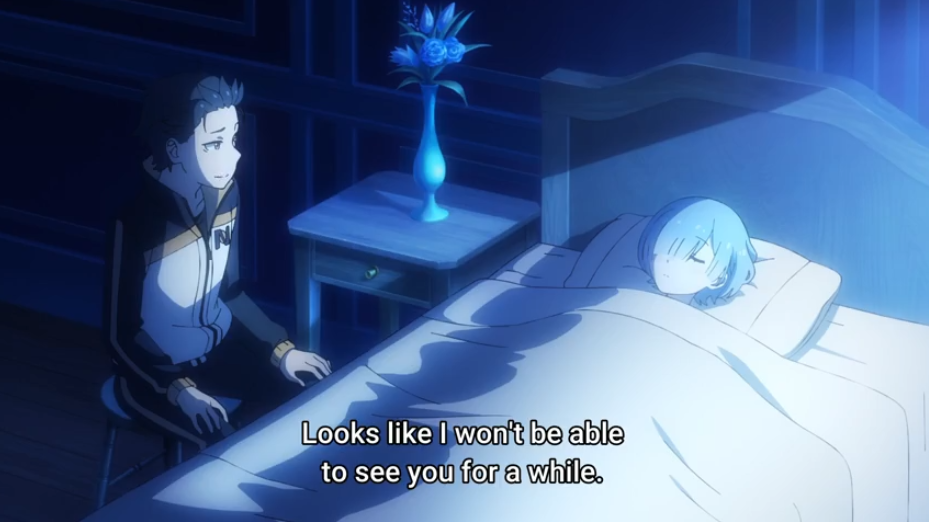
Still, although I prefer my stories in 22-25 minute chunks, one can hardly expect a studio to turn down such a time slot. Subaru befriends a loli bard, Liliana, by joining in one of her street performances, and she recognizes him for his fame; for all his suffering and rebooting he’s managed to accomplish some valorous deeds… and to get himself teased a bit and called a lolimancer. XD
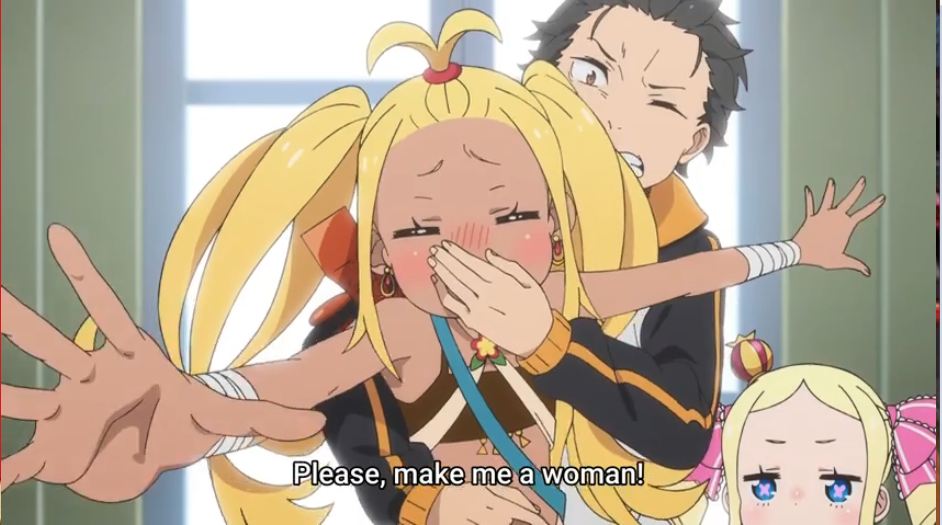
There’s some family drama and touching moments in house van Astrea, with Wilhelm’s regrets and tension with his grandson Reinhard, who blames him for losing his wife (their grandmother) to the White Whale, and his alcoholic son (Reinhard’s father) Heinkel ruining everything.
Unfortunately, Subaru hasn’t done enough to reach easy mode yet, and his suffering isn’t over. The archbishop of wrath, Lusbel, has kidnapped a boy who she tortures horrifically; he’s limbless and has wet himself in the first Bad End before she makes his (and everyone else’s) head explode, to end the marathon first episode. He’s a brave boy, who endures to protect his friend Tina; unfortunately, this also means refusing Subaru’s rescue attempt in the next episode.
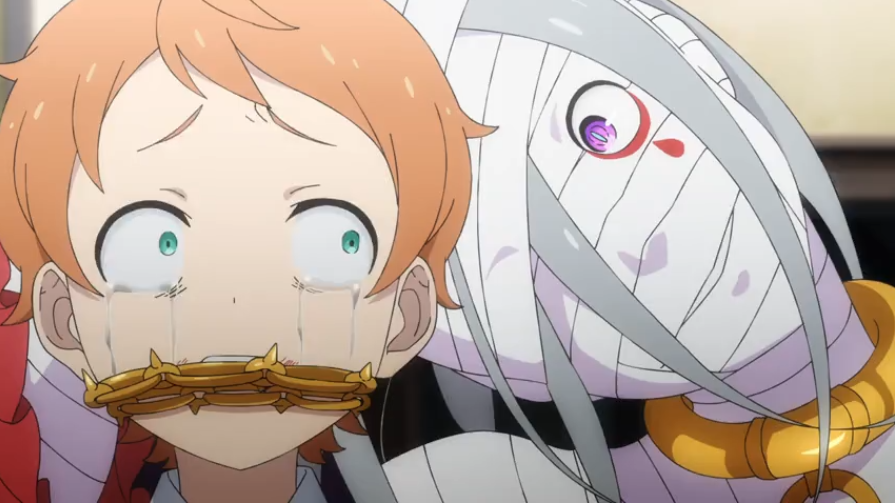
Once Subaru knows what’s coming, he tries to get help, but this is a whole story arc and not a single episode; we learn that another archbishop, Regulus, has designs on Emilia, and that Sirius absolutely hates her for it; after some cool moments from the normally quiet Emilia, it ends with her defeat and Regulus saying he’s come to take her as his 79th wife.

Tensei Kizoku, Kantei Skill de Nariagaru doesn’t let Ars (now running Lamberk, after the death of his father Raven at the end of the first season) recruit anyone new in its first three episodes – as the focus on high politics, in an empire on the verge of civil war, instead takes center stage. We should not forget the central role of politics to the lives of historical aristocrats - power, once obtained, is easily lost, and less easily expanded – and Ars, no matter how good his advisors, is in a situation familiar to many a Crusader Kings player, ruling a tiny part of Missian with a lord plotting a dangerous independence, viewing dynastic weakness as the cause of the continent’s fractious internal politics.
Lord Lumiere is smart enough to seek to consolidate power locally first, however, and has to win the war with Vasmarque. Ars’ fiancee/wife (marrying at the first episode’s end) Licia gets to show off her diplomatic skill, and the party goes on an episode-long mission to bribe the prime minister and thereby obtain aid from the neighboring province of Paradille; one is reminded of the lingering importance of the court in Japan's Sengoku Jidai, when being declared a rebel could have fatal consequences - not from the central government's own (nominal) forces, but at the hands of one's neighbors.

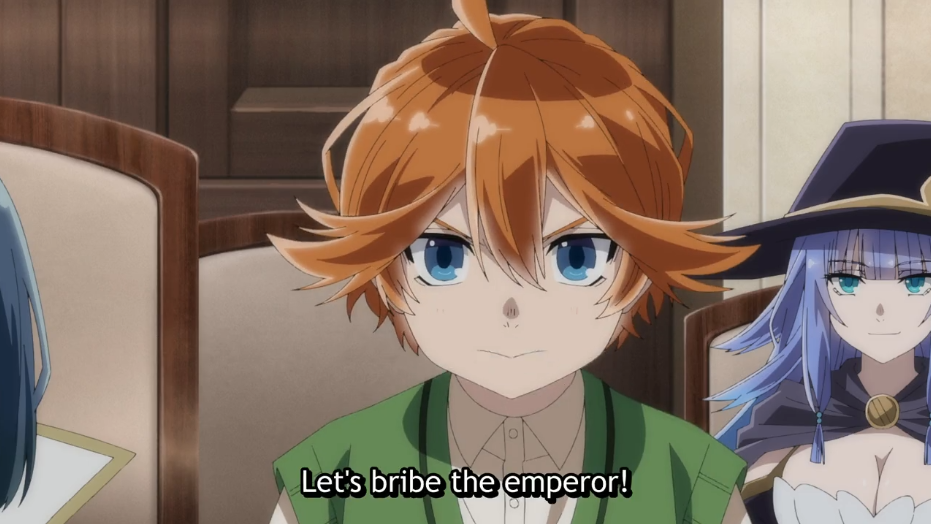 Even the outburst of Lord Lumiere’s son, Rengue, was part of her plan and works perfectly; the stubborn, straightforward heir grows up a bit, asks for diplomacy tutoring, and turns his old reputation to his house’s advantage, spreading rumors that it is in fact Vasmarque’s faction behind the Missian independence movement.
Even the outburst of Lord Lumiere’s son, Rengue, was part of her plan and works perfectly; the stubborn, straightforward heir grows up a bit, asks for diplomacy tutoring, and turns his old reputation to his house’s advantage, spreading rumors that it is in fact Vasmarque’s faction behind the Missian independence movement.
Then it’s a visit to Raven’s grave and they’re off to war.

Maou-sama, Retry!'s first season aired before I started keeping this blog, and I must confess it did not make a strong impression on me, although I did finish the first season. The title character’s background makes it easy to think of as an Overlord clone, and he is indeed stuck in an MMO-based world as the Maou. Two major differences come to mind; he was a developer on the original game, not simply a player, and while Ainz is manipulated by his followers into, and slowly begins accepting, the part of an actual demon king, Hakuto just wants to run a hot springs resort and chill, although he and his followers are admittedly no pacifists.

The first episode of Maou-sama, Retry! R could be mistaken for a remake, with much of the plot focusing on his friendship with a NEET gaming buddy (a more common phenomenon than outsiders might realize; it sometimes seems like the only otaku *not* struggling financially are working in tech) and the rest on how he meets and befriends Aku, before zooming through the rest of season 1 in the last couple minutes to catch the audience up. His friend didn’t find success in the industry, but he did make a kind of horrifying aquarium sim, complete with man eating fish; the flashbacks continue into the 2nd episode before the OP plays.

Back to the main plot, we’ve got a world with church-backed discrimination against demihumans, especially rabbits, and (re)introducing the rest of Hakuto’s harem. Episode three gives us a hero named Otamega drawing crowds and helping the poor, a repelled attack on Rabby village, and a gruesome punishment for one of the perpetrators. Finally, we have a dungeon complete with a recycling plant for monsters and adventurers alike, and a mysterious and disturbing message; I can’t help but think of Keramon’s “hello!!”

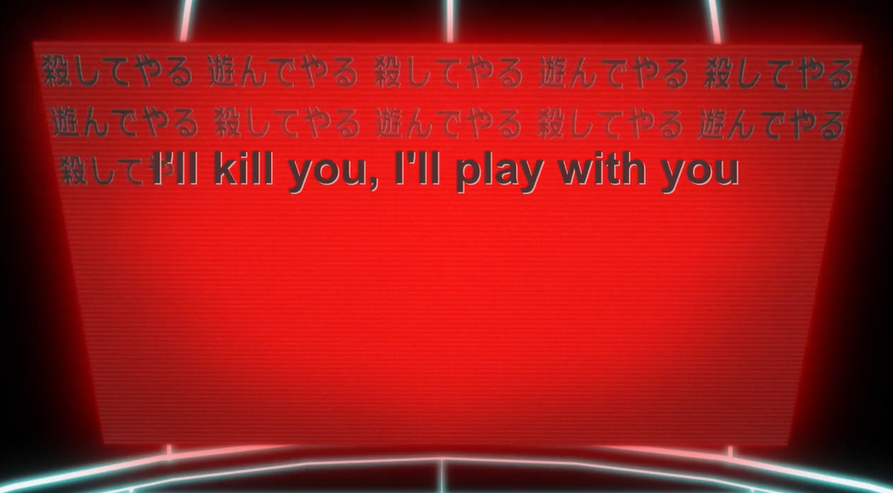 Hakuto blows up the screen, determined to fight back; I’m intrigued to see what becomes of their power struggle.
Hakuto blows up the screen, determined to fight back; I’m intrigued to see what becomes of their power struggle.
Seirei Gensouki’s first season also aired years ago and failed to make a strong impression on me. Then again, that season was an isekai tensei set in a magic academy; this one gives us a summoning circle and adjusting to the new world, complete with an attempted kidnapping, which is foiled by last season’s MC, and helping them around the language barrier with his contracted spirit Aishia.
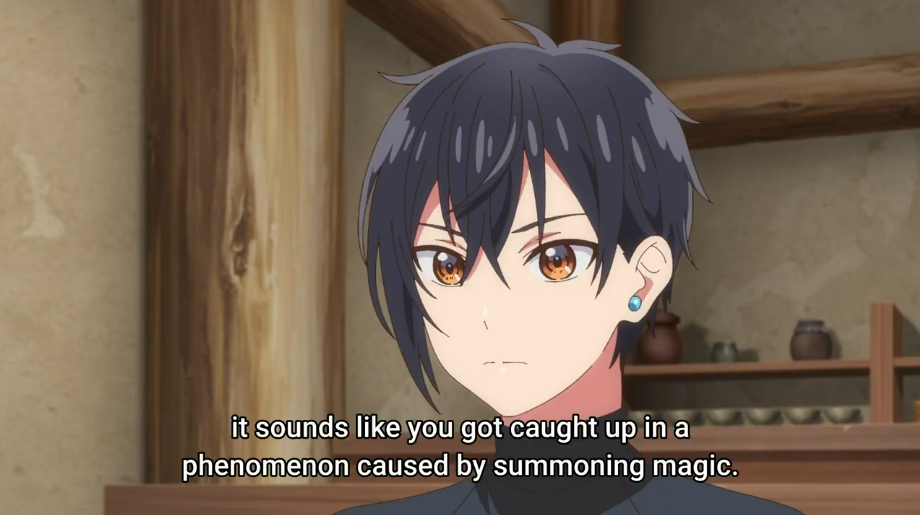

It’s always interesting to see interactions between characters who arrived in the other world in different ways, or (in the pre-tensei era) at different times; Mushoku Tensei’s Nanahoshi and Tate no Yuusha no Nariagari’s four heroes comes to mind, or in older periods, the miko before Miaka and Yui in Fushigi Yuugi or the World War 2 veteran in Juuni Kokuki.
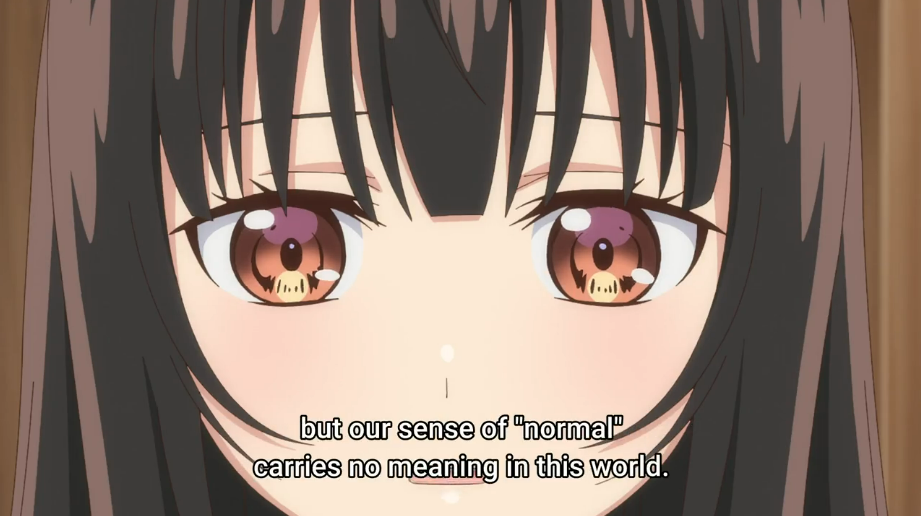 Unfortunately, although it might set up character relationships, the 2nd episode is a bit too slow; sleeping arrangements, changing clothes, and Japanese food do not match the season premiere’s excitement. I hope the season as a whole will be more like the 1st episode than the 2nd.
Unfortunately, although it might set up character relationships, the 2nd episode is a bit too slow; sleeping arrangements, changing clothes, and Japanese food do not match the season premiere’s excitement. I hope the season as a whole will be more like the 1st episode than the 2nd.
Finally, Arifureta Shokugyou de Sekai Saikyou returns for its 3rd season. Maou-sama Retry! R isn’t the only anime this season dealing with the mistreatment of bunny girls, although I suppose demihuman enslavement has been a common story element since Tate no Yuusha became a hit.
Hajime is reluctant to intervene against the militaristic Verbergen Empire at first; its hard to change a world he barely understands, and so much could go wrong. He’s far more interested in protecting his immediate social circle.
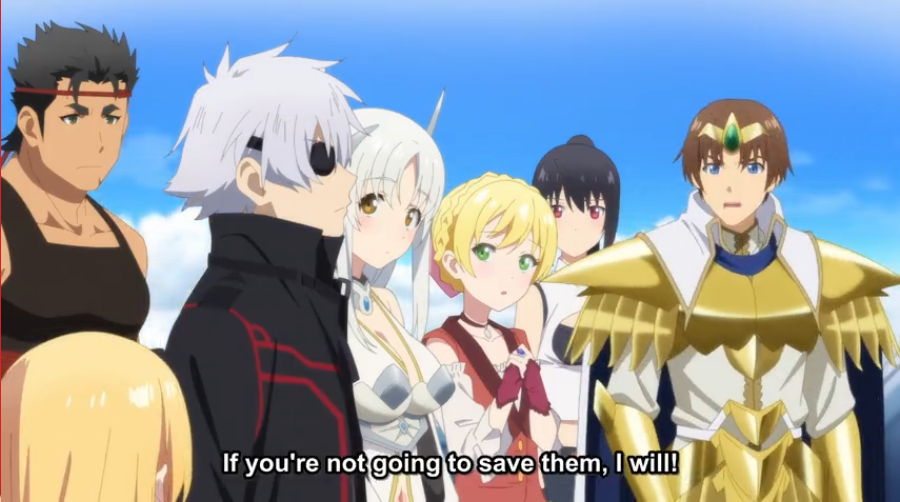
But he has connections with the Haulia in particular, with Shea a party member, and had trained the group of bunnies now resisting in the past. So once he spots them fighting back alone, Hajime decides to intervene.

We learn that monster attacks had hit both Verbergen and the bunnies, prompting slave raids from the former against the latter.

We also learn that the rabbit guerillas had gone full chuuni, and are even debating what new nom de guerre to give Hajime, and there’s an amusing bit about Hajime-tachi’s airship and being thought of as like aliens.
But winning a skirmish or two doesn’t stem Shea’s worries; is her father okay?
 It looks like this season of Arifureta will be about liberating cute bunny girls, and it should, if nothing else, be an entertaining ride.
It looks like this season of Arifureta will be about liberating cute bunny girls, and it should, if nothing else, be an entertaining ride.